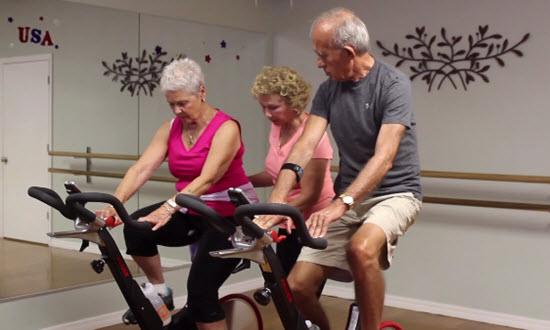
Meet Master Parkinson’s Cycling Coach Kathy Helmuth and learn how you can train to become an ACE accredited Parkinson’s Cycling Coach by listening to our announcement podcast below.
Cycling on stationary bikes may provide symptomatic relief for people with Parkinson’s disease, especially if they cycle using what’s described as Forced Exercise, i.e. pedaling at a rate faster than their voluntary cadence. This was the finding of a study at a scientific meeting in the US in 2012. Researchers found cycling, especially at rates above what patients would choose for themselves, appeared to make regions of the brain that deal with movement connect to each other more effectively.
Approximately 7 to 10 million people all over the world live with Parkinson’s disease. Parkinson’s disease is a chronic, progressive neurological disorder where part of the brain gradually becomes more damaged as the years go by. The main symptoms of the disease are movement related.
For their study, Dr. Jay Alberts and co-researcher Chintan Shah, and other colleagues from the Cleveland Clinic, used MRI brain scans to investigate the effect of exercise on 26 patients aged from 30 to 75 with mild to moderate Parkinson’s disease. This testing measured the changes in blood oxygen in the brain, which enabled the researchers to look at how active different brain regions are and how well they connect with each other.
The researchers randomly assigned the patients to one of two groups. One group (13 patients) cycled at their own voluntary pace, while the other group cycled at a forced rate ( forced exercise).
The 2 groups cycled three days/week for 8 weeks. An MRI scan of the brain was done at the beginning and at the conclusion of the 8 week period. A followup MRI brain scan was done 4 weeks after the study was concluded. The rate of exertion was controlled by a motor on the bike of the Forced rate or Forced exercise group of cyclists. The researchers also measured the rate of perceived exertion of the cyclists.
During the study researchers calculated brain activity and connectivity levels with the MRI brain scans. After reviewing the brain scans, the conclusion was drawn that the fast pedaling group of cyclists had better brain connectivity. That improved brain activity was between the primary motor cortex and the posterior region of the brain’s thalamus. The improvements were still observed through the MRI scans at the 4 week followup test.
One of the researchers suggested that this study shows that “forced-rate bicycle exercise is an effective, low-cost therapy for Parkinson’s disease”.
The Parkinson’s Cycling Program is useful for people with Parkinson’s disease due to the balance challenges that many experience. Indoor group cycling lead by a trained coach provides a monitored and safe exercise protocol. The participant is able to pedal in a controlled environment while being observed as well as coached properly. The support of the group class enhances the experience so the exercise behavior becomes routine and part of every day life.
There are other benefits of the Parkinson’s Cycling Program as well. Most Parkinson’s individuals are quite sedentary due to symptomatic issues and difficulty with the daily activities of life. Group cycling gives that individual the opportunity to build the muscles of the lower leg in a safe way. As the quadriceps, hamstrings, and calves become stronger, everyday activities become somewhat easier to handle.
The people with Parkinson’s who are involved in this program also begin to see an increase in energy levels – common for all populations of people who become more active and physically fit. With proper bike fit, these new riders put less stress on their knees, ankles, and spine while increasing their lower body strength. This is truly beneficial to the population who experience movement issues due to Parkinson’s disease.
Click Here to learn how you could provide Parkinsons’ Cycling Classes at your club or studio.
Additional research
The Effects of Forced Exercise on Parkinson’s Motor and Non-motor Symptoms – video presentation by Dr. Jay Alberts that expands on the concept of forced exercise how it can bring symptomatic relief to people with PD.